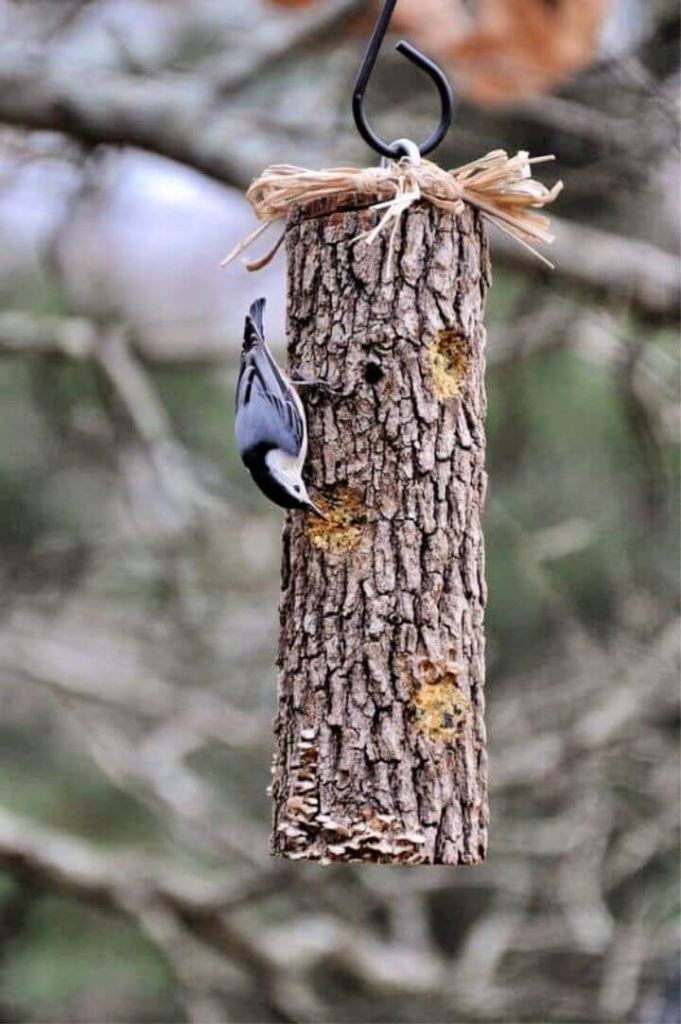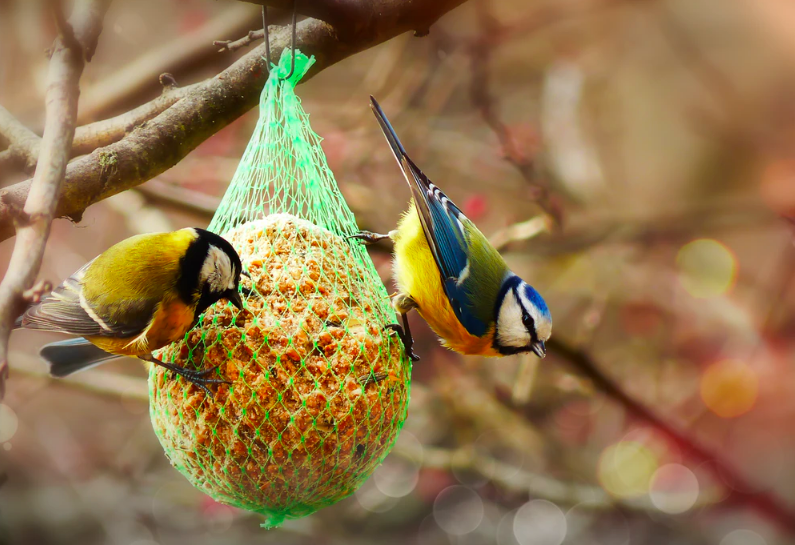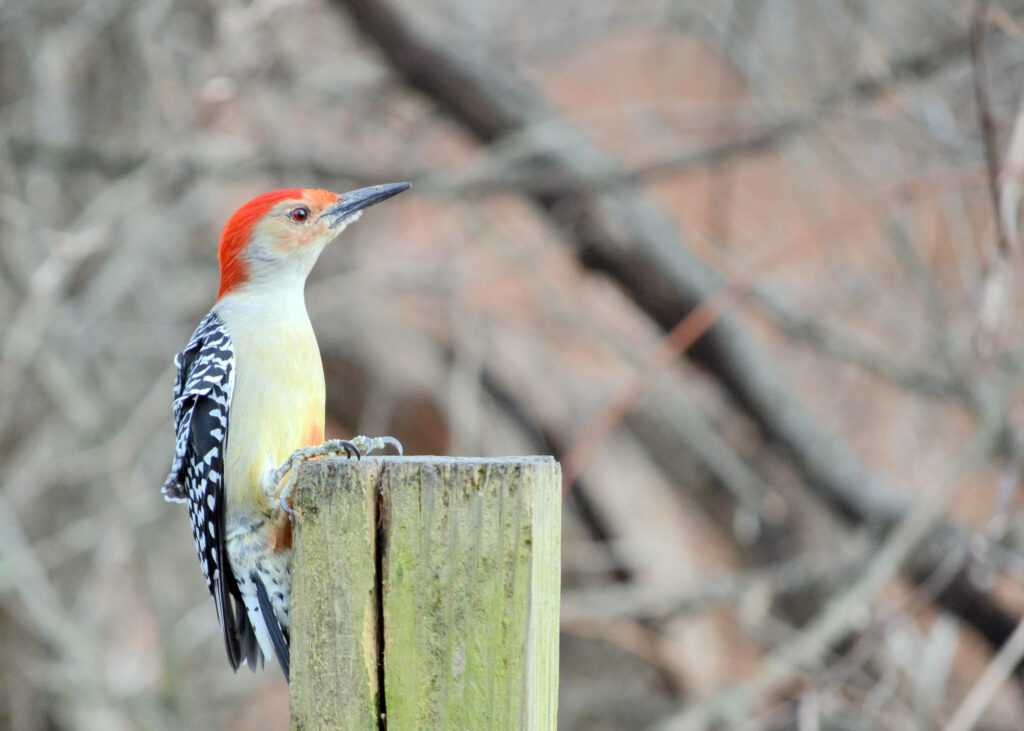If you’re thinking about installing a suet feeder in your garden, you should take some extra time to learn about your equipment and how it operates.
Learning how to hang suet feeder to attract more birds is one of the most important things you can do.
This article is the final answer to all your questions if you are concerned about making a suet feeder work as it should.
1. Choose a Location That Is Wind-Free And Sheltered
Choosing a windless location for your feeder not only provides a haven for birds but also helps to prevent suet leakage. It’s possible that your site isn’t particularly windy at first.
Bird feeders or hangers should be removed during heavy winds, hurricanes, or other extreme weather since the wind can dissipate, spill, and destroy the feeders. However, this isn’t the only issue.
In windy conditions, large broken branches can also be a hindrance to birds and feeders. If your climate is especially prone to storms and wind, it is, therefore, advisable to place feeders in safe areas.
A sheltered location will streamline the procedure, making it safer for the birds while also making filling and maintenance easier for the owners.
2. Choose a Location That Is Close To Bushes And Trees

Suet can also be hung on tree branches or in densely forested areas. Because trees are their natural habitat, placing your feeders on (or under) the surrounding trees and bushes will provide more safety and comfort for birds.
If you do this, squirrels and raccoons will have easier access to the suet. To remedy the problem, consider adding suet to another feeder.
3. Feeders That Are Suspended Upside Down On A Pole
A “Starling Proofing the Suet” DIY solution appeared ideal after experimenting with many sites and tactics for suet feeder placement several years ago. When birds begin to contaminate suet feeders, relocate them to a different area. There will be a noticeable difference!
You can bring two dual-hook shepherd’s poles with barrel raccoon baffles to keep squirrels and raccoons at bay. To one of the shepherd’s hooks, add a second arm.
You now have five spots to hang the Birds Choice Upside Down Suet Feeders, which you can fill with suet. This is how the suet has been distributed, and it has proven to be effective.
Choosing The Best Pole Site
The birds won’t be able to eat the suet if they don’t see the feeders. As a result, making your feeders visible is essential. If you’ve previously installed seed feeders, you can set the suet feeders close by — but not too close.
Suet-eating birds may find seed-feeding activities appealing, and as a result, the suet feeder will be discovered fast. If your birds are a little wary, position the feeder in a prominent location, such as the middle of your backyard. You can put your suet feeders in a more hidden area once they’ve gotten used to it.
A few steps from a large living room window, one of these shepherd’s hook poles may be found in the front yard. There are two suet feeders on this one. It’s close enough to the front window to prevent bird strikes.
It’s also close enough to the front porch for Downy Woodpeckers to hold briefly to the vertical wood bars of the railing before flying to the feeder. Fortunately, despite their proximity to the porch and the house, the squirrels have avoided it entirely. From the living room, it’s simple to observe the birds at these feeders.
The other pole should be about thirty feet away from the back door in the backyard. From the kitchen and dining room windows, it may be visible. This is the one with the extra small arm holding three suet bags.
Keeping Suet Away From Other Feeders By Hanging It
Both poles should have suet feeders, and the nearest seed feeders are at least twenty feet away. Even just a few inches apart, the attempts to pair suet feeders with seed feeders failed miserably. It is vital to keep them at least this distance apart for a couple of reasons.
First, offering suet near or on seed feeders may frighten some of the birds you’re attempting to attract. When other birds are nearby, bolder sociable species like Carolina Wrens or Blue Jays are usually OK eating suet. On the other hand, solitary birds such as Downy and Red-Bellied Woodpeckers do not prefer to dine in noisy flocks of birds.
Second, even if you only put suet feeders on one pole but situate it too close to other feeders, other birds will utilize the tops of the shepherd’s hooks as a resting spot before flying over to the seed feeders. The birds at the suet feeders are once again disturbed. When it comes to woodpeckers, it’s essential to leave plenty of space.
You might wonder if numerous birds would be willing to eat simultaneously because two or three suet feeders are on the same pole. You will never observe all three suet feeders operating simultaneously, but you may see two of them frequently.
If You Don’t Want To Use A Pole
Poles are the most proper technique to keep squirrels away from a suet feeder. However, a pole may not be something you want to utilize in your garden. If that’s the case, you may use other approaches to keep squirrels away from suet feeders hung on trees.
Types Of Suet Feeders
Suet comes in various shapes and sizes, ranging from large chunks to small balls and crumbles. While the values for birds remain the same, suet comes in multiple forms and sizes to suit various purposes and hanging procedures.
1. Suet Cage

Suet cages are the most common type of suet feeder. The cages are more durable and easy to clean, thanks to the use of coated wires. When not in use, the feeder can be placed independently or attached to hopper feeders storing seeds.
Modern models also feature tail reinforcements, which protect the birds and suet from dangerous animals and adverse environmental conditions.
If you are looking for a recommendation then check this Suet Cage on Amazon. This is the one I have and it’s really good.
2. Suet Log

Suet logs have a realistic avian habitat and a normal treetop with suet-filled pre-drilled slots. To get the best results, place these feeders near or on tree branches in a shady area. It’s great if the feeder is close to the birds’ shelters or a food source they frequent.
If you are looking for a recommendation then check this Suet Log on Amazon. This is the one I have and it’s really good.
3. Mesh Bags

Diamond fire tails, pink robins, and chickadees all benefit from mesh bags. These bags are also helpful for both recycling and transporting suet. You can immediately place the suet in a reusable bag, such as those used for onion packing. The easiest way to attract birds is to hang these feeders in plain sights, such as on a tree or the porch.
4. Open Trays
Finally, open trays give your suet to various birds, particularly those that dine on the ground. These versatile feeders are simple to mount on a window, a pole, the ground, or any other suitable structure.
Suet feeders come in a range of shapes and sizes and can be hung in various ways. However, you must be eager to learn about the most efficient way. Experts have developed the optimum approach for feeding suet to birds for several years. Through a lot of trial and error with feeder kind and location, they’ve learned a lot about feeders and where to hang them.
The following suet setup has performed wonderfully season after season. You don’t have to be concerned about it anymore. It just works.
Birds On Suet Feeders

The two varieties of woodpeckers and the wrens are the most frequent visitors to the suet feeders. On the other hand, Carolina Chickadees, and White-Breasted Nuthatches will occasionally take a nibble.
When passing through the yard, the occasional Pine Warbler will eat suet. Blue Jays will dangle for a few moments in the spring to acquire some suet for their young. European Starlings perform the same thing in late winter, but because the feeders are upside down, they get tired of it quickly.
Eastern Bluebirds may also take a quick bite of suet. Various birds may occasionally rummage on the ground beneath the feeders, snatching up bits of suet that have fallen from other birds.
Of course, good-quality poles and baffles aren’t cheap, but you’ll discover that by delivering suet in this more secure manner, you won’t have to restock the suet feeders as often as you did before. So, in the long run, your one-time expenditure is saving you money, and the birds appear to be happy.
Look For Common Bird-Feeding Issues
Last but not least, make a list of the most prevalent suet feeding issues.
1. Suet Spoiling and Melting
Conventional fat makes up most suet; it will melt and deteriorate in extreme heat and direct sunshine. One solution to this vexing problem is buying the latest ready-made suet, which contains components that can withstand higher temperatures. Furthermore, placing your feeders in a shady spot can help you avoid this aggravating issue.
Additionally, make sure you have enough suet for the birds to devour in one or two days. To keep unused suet fresh, store it in the freezer or refrigerator. You may give suet to your birds all year without worrying about the heat after you’ve become used to it.
2. Accessibility
Feathers and spillage might make the environment uninhabitable for the birds, causing them to flee. Suet deficiency is no exception. As a result, it’s critical to keep the area clean and ensure that suet is replenished regularly.
If you have to take extra steps to get to your feeders, you’ll probably forget to clean or refill them. As a result, the optimal location for your feeder should be convenient for both you and the birds.
Final Words
Be patient if birds don’t come to your feeders. Birds may take a long to notice the feeder and may be hesitant to risk their lives by hunting and investigating the new location right once.
If you haven’t had any results after 2-3 weeks, try relocating your feeder and waiting some more. If that doesn’t work, consider building a birdbath with vivid colors, providing nearby perches, and regularly refilling the suet.
That’s all there is to know about suet feeding and how to hang a suet feeder properly. As a bonus, you are provided numerous solutions to some perplexing difficulties. Suet feeding is complex, and it may take a long time to get used to. Be patient, and you’ll get it someday!
FAQ
Why aren’t the birds visiting the suet feeder?
There could be several causes for this. For starters, birds can take days or even weeks to discover a new feeder. Perhaps you placed the feeder in an area with too much human activity, predator activity, or even bird activity.
Without a feeder, how do you hang suet?
While suet feeders are popular, suet can also be served without the use of a specialist feeder. For woodpeckers, nuthatches, and creepers, soft suet can be sprinkled directly on the bark of a tree. If suet is too difficult to spread, gently heat it until it softens and spreads.
Last Updated on March 22, 2023 by Lily Aldrin
